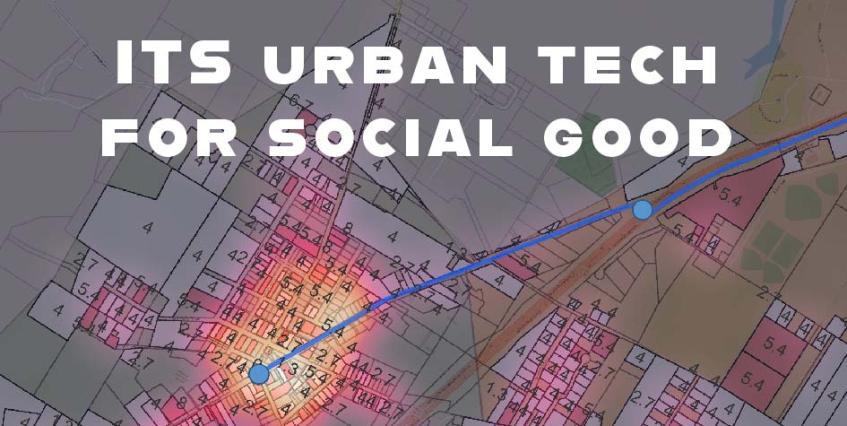Urban Technology for Social Good
The advancement of urban technology holds the potential to generate immense social change. Providing technological solutions for the accessibility of transit, management of traffic systems, and development of infrastructure can yield concrete benefits toward enhancing public good. Systems of transportation in both metropolitan and rural communities have adopted various forms of smart technology to promote social welfare. When utilized effectively, urban technology bridges inequalities; Students at the McClure School aim to heighten access to public transit while collecting geographical data based on citizens’ transportation needs. Urban technology can also be applied in order to improve the efficacy of communication between emergency services, improving response times and overall citizen safety.
Modern issues surrounding transportation are primarily caused by a deficit in accessibility. In southern Ohio, over 6,000 households are “no-car” homes; financial circumstances prevent many from being able to afford cars, making thousands reliant on public transit. This lack of access is only worsened by the underdevelopment of transportation infrastructure in rural regions. Furthermore, systems of public transportation are heavily flawed. Bus stop locations in rural landscapes are scarce, forcing people to walk on highways in order to travel. Many rural areas do not have bus stops at all. Incorporating urban technology to account for defects in transit systems not only improves the efficiency of travel but also serves public welfare through equitable solutions for accessible transportation.
However, certain technologies aren’t always the best answer when addressing transportation issues. The use of smart technology harbors the potential to complicate transportation systems, generating inefficient transit while failing to promote social good. Automated traffic lights in Pittsburgh aim to make use of urban technology in order to boost the function of traffic systems. The impacts of this technology’s implementation have also limited sidewalk access, eliminating various bus stops to accommodate preprogrammed traffic lights. Given that a large portion of citizens can’t afford a vehicle, automatic traffic lights perpetuate socioeconomic barriers when safe walking paths are eliminated. Regardless of the purpose automated lights serve for traffic management, the cost to overall citizen welfare prevents this technology from truly serving the people.
Smart technologies may also be disproportionately expensive when compared with the purposes they serve. Implementation and maintenance costs alone require a level of financial flexibility many rural communities simply cannot bear. Operational expenses for public bus transit often prevent smaller cities from being able to establish transport systems. Financial challenges brought on by public transit directly harm citizen welfare when cities can’t afford the necessary infrastructure. When costly technology is implemented only for its outcomes to damage citizens’ access to transportation, the harms of its establishment dominate potential benefits.
At Ohio University, students at the McClure School address issues with transportation access and technology head-on. Through a series of projects constructed with the goal to improve transportation infrastructure, students are educated about the complexities behind transit technology. Creating solvency for real-world transportation inequalities involves a deepened understanding of citizens’ needs in relation to their local communities. Students at the McClure School are tasked with developing more cost-effective, simpler technologies for rural communities.
Developing viable routes, calculating user requirements, and measuring maintenance infrastructure are necessary components for providing a well-rounded technological solution for modern transit issues. Different communities have unique needs; students’ work in addressing each element of travel equips them with the knowledge to create innovation for any transportation concern.
McClure students enrolled in the ITS 5900/4900 course, also known as Urban Technology for Social Good, study the possibility of deploying two autonomous transit lines in the Appalachian region. This fall, students split into groups either studied a route from Athens to The Plains and back, or Athens to Albany and back. In part A of the project, students define user and system requirements in the region while taking into account geographical data in a Geographic Information System project.
User requirements include the origin and destination, frequency and coverage, accessibility, affordability, and comfort of the trips. Students analyzed system requirements in three categories: route, location of stops, and accessibility for users. They also needed to assess how well each system requirement fully or partially fulfills user’s needs.
In Part B, students took their defined system requirements and designed technological solutions to solve transit issues in the Appalachian region. This includes bus stop requirements. For each stop, students indicated the necessary infrastructure to implement, operate and maintain the transit service. Route requirements show the necessary autonomous bus technology, storage and parking facilities, maintenance facilities and costs, and charging facilities needed to implement.
The McClure School of Emerging Communication Technologies strives to offer the best academic programs in the IT (Information Technology), the game development and the Virtual Reality/Augmented Reality (VR/AR) industries. Our programs and certificates cover numerous aspects of the rapidly changing industries of information networking, cybersecurity, data privacy, game development), digital animation and the academic side of esports.
